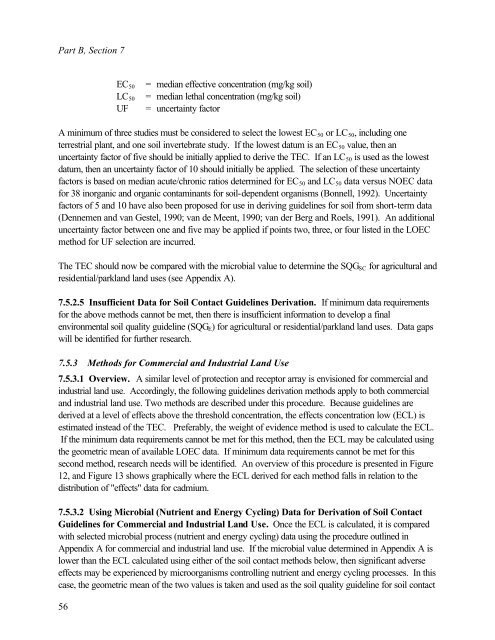Protocol for the Derivation of Environmental and Human ... - CCME
Protocol for the Derivation of Environmental and Human ... - CCME
Protocol for the Derivation of Environmental and Human ... - CCME
Create successful ePaper yourself
Turn your PDF publications into a flip-book with our unique Google optimized e-Paper software.
Part B, Section 7<br />
EC 50<br />
LC 50<br />
UF<br />
= median effective concentration (mg/kg soil)<br />
= median lethal concentration (mg/kg soil)<br />
= uncertainty factor<br />
A minimum <strong>of</strong> three studies must be considered to select <strong>the</strong> lowest EC 50 or LC 50 , including one<br />
terrestrial plant, <strong>and</strong> one soil invertebrate study. If <strong>the</strong> lowest datum is an EC 50 value, <strong>the</strong>n an<br />
uncertainty factor <strong>of</strong> five should be initially applied to derive <strong>the</strong> TEC. If an LC 50 is used as <strong>the</strong> lowest<br />
datum, <strong>the</strong>n an uncertainty factor <strong>of</strong> 10 should initially be applied. The selection <strong>of</strong> <strong>the</strong>se uncertainty<br />
factors is based on median acute/chronic ratios determined <strong>for</strong> EC 50 <strong>and</strong> LC 50 data versus NOEC data<br />
<strong>for</strong> 38 inorganic <strong>and</strong> organic contaminants <strong>for</strong> soil-dependent organisms (Bonnell, 1992). Uncertainty<br />
factors <strong>of</strong> 5 <strong>and</strong> 10 have also been proposed <strong>for</strong> use in deriving guidelines <strong>for</strong> soil from short-term data<br />
(Dennemen <strong>and</strong> van Gestel, 1990; van de Meent, 1990; van der Berg <strong>and</strong> Roels, 1991). An additional<br />
uncertainty factor between one <strong>and</strong> five may be applied if points two, three, or four listed in <strong>the</strong> LOEC<br />
method <strong>for</strong> UF selection are incurred.<br />
The TEC should now be compared with <strong>the</strong> microbial value to determine <strong>the</strong> SQG SC <strong>for</strong> agricultural <strong>and</strong><br />
residential/parkl<strong>and</strong> l<strong>and</strong> uses (see Appendix A).<br />
7.5.2.5 Insufficient Data <strong>for</strong> Soil Contact Guidelines <strong>Derivation</strong>. If minimum data requirements<br />
<strong>for</strong> <strong>the</strong> above methods cannot be met, <strong>the</strong>n <strong>the</strong>re is insufficient in<strong>for</strong>mation to develop a final<br />
environmental soil quality guideline (SQG E ) <strong>for</strong> agricultural or residential/parkl<strong>and</strong> l<strong>and</strong> uses. Data gaps<br />
will be identified <strong>for</strong> fur<strong>the</strong>r research.<br />
7.5.3 Methods <strong>for</strong> Commercial <strong>and</strong> Industrial L<strong>and</strong> Use<br />
7.5.3.1 Overview. A similar level <strong>of</strong> protection <strong>and</strong> receptor array is envisioned <strong>for</strong> commercial <strong>and</strong><br />
industrial l<strong>and</strong> use. Accordingly, <strong>the</strong> following guidelines derivation methods apply to both commercial<br />
<strong>and</strong> industrial l<strong>and</strong> use. Two methods are described under this procedure. Because guidelines are<br />
derived at a level <strong>of</strong> effects above <strong>the</strong> threshold concentration, <strong>the</strong> effects concentration low (ECL) is<br />
estimated instead <strong>of</strong> <strong>the</strong> TEC. Preferably, <strong>the</strong> weight <strong>of</strong> evidence method is used to calculate <strong>the</strong> ECL.<br />
If <strong>the</strong> minimum data requirements cannot be met <strong>for</strong> this method, <strong>the</strong>n <strong>the</strong> ECL may be calculated using<br />
<strong>the</strong> geometric mean <strong>of</strong> available LOEC data. If minimum data requirements cannot be met <strong>for</strong> this<br />
second method, research needs will be identified. An overview <strong>of</strong> this procedure is presented in Figure<br />
12, <strong>and</strong> Figure 13 shows graphically where <strong>the</strong> ECL derived <strong>for</strong> each method falls in relation to <strong>the</strong><br />
distribution <strong>of</strong> "effects" data <strong>for</strong> cadmium.<br />
7.5.3.2 Using Microbial (Nutrient <strong>and</strong> Energy Cycling) Data <strong>for</strong> <strong>Derivation</strong> <strong>of</strong> Soil Contact<br />
Guidelines <strong>for</strong> Commercial <strong>and</strong> Industrial L<strong>and</strong> Use. Once <strong>the</strong> ECL is calculated, it is compared<br />
with selected microbial process (nutrient <strong>and</strong> energy cycling) data using <strong>the</strong> procedure outlined in<br />
Appendix A <strong>for</strong> commercial <strong>and</strong> industrial l<strong>and</strong> use. If <strong>the</strong> microbial value determined in Appendix A is<br />
lower than <strong>the</strong> ECL calculated using ei<strong>the</strong>r <strong>of</strong> <strong>the</strong> soil contact methods below, <strong>the</strong>n significant adverse<br />
effects may be experienced by microorganisms controlling nutrient <strong>and</strong> energy cycling processes. In this<br />
case, <strong>the</strong> geometric mean <strong>of</strong> <strong>the</strong> two values is taken <strong>and</strong> used as <strong>the</strong> soil quality guideline <strong>for</strong> soil contact<br />
56
















